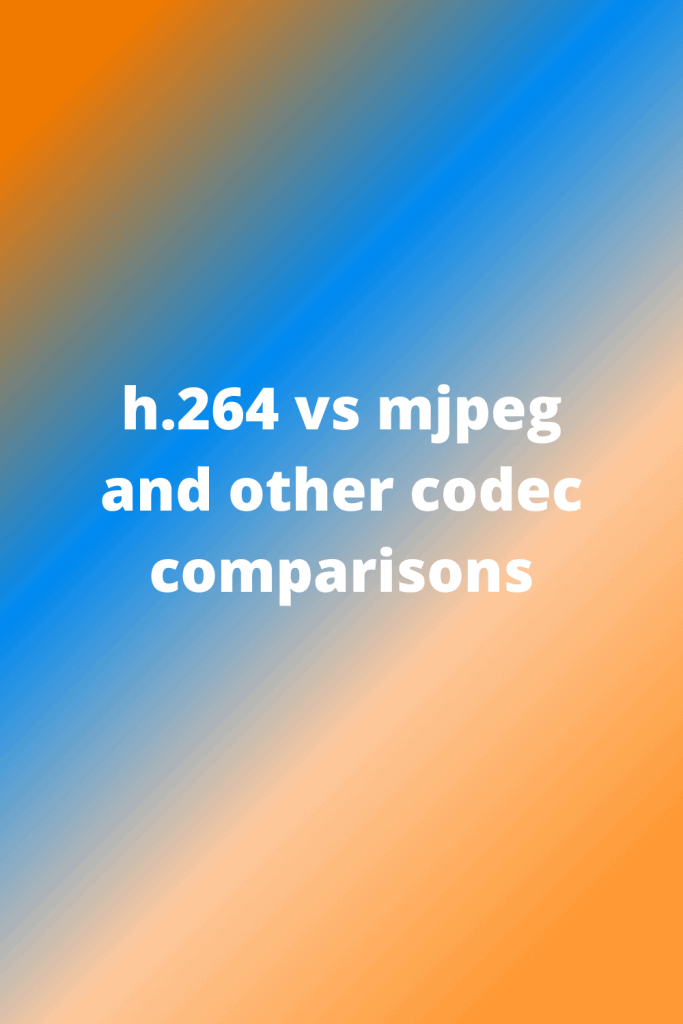h.264 vs mjpeg and other codec comparisons Overview
Codecs are methods that help compress media files from a source, such as videos, and transfer its contents to another receiver in a network. h.264 vs mjpeg will show the difference between these two formats.
Want to find the appropriate codec according to your streaming needs? Here are common codecs and their comparisons:
mjpeg vs mpeg4
Handling videos in most computers involves the standard motion-jpeg (or mjpeg) codec.
The format of mjpeg compresses each frame of video content separately into individual pictures. On the other hand, mpeg4 (deriving its name from the Motion Picture Experts Group committee) has a more complex compression method, but it reduces the amount of data transferred in compression compared to the former. Check out best security cameras for home wireless on Amazon
mjpeg bandwidth
In mjpeg, bandwidth (the network rate in transferring data) is fairly higher compared to other codecs, say between the codecs h.264 vs mjpeg, Due to individual frames compressed, the mjpeg codec produces a greater content quality.
mjpeg audio
Because of its simple method of coding, an older version of mjpeg does not code for audio files.
This is because its compression involves only a collection of individual picture frames that are strung together in its final output.
In the new mjpeg codec version, one of its advantages is that it can carry audio.
Also, its compression in audio files produces lesser lagging issues when compared to mpeg4.
h264 vs h265
h265 is also known as High-Efficiency Video Codec (HEVC). Its method is to compress video content for quality live streaming, particularly 4k video types on the internet.
This is compared to the standard h264 or Advanced Video Codec (AVC) on most devices only attributed to normal kinds of streaming like HD displays.
Differences between different formats against MPEG
Introduction
The MPEG format stands for Moving Picture Experts Groups. It is a group of ISO and family of comprehension standards and digital video file formats developed by this particular group.
2- RTSP vs. MJPEG.
RSTP format videos send a specific display quality. This cannot be changed until the video is restarted.
Packets are going to be transmitted via UDP, this means it can cause problems with firewalls. This is the go that does not happen with MPEG videos.
The videos in this second format want to combine all the available technologies.
This makes it possible to change the display quality in full playback of the video. So there are no problems with Internet protocols.
3- MPEG4 vs. H264.
The H264 format is a form of video encoding that offers an advanced understanding of the MPEG4 format.
It also has a sharper and superior image. Along with all this, it should be noted that it works with a larger bandwidth on the network.
Therefore, the H264 format is the most effective for video surveillance that is done by mobile phone.

4- MPEG2 vs. H264.
The most important difference that can be highlighted is that the MPEG2 format is used only for the playback of a DVD, regardless of whether it is more or less old.
However, the H264 format can be used on all types of available devices.
This will depend on whether the disk that we have is pure where we can put all the files that we want, or it is a video disk that we have bought or have created.
In the first case, we are going to be able to play videos in the format you want, but in the second case, it is not so, it can only be reproduced with the MPEG2 format.
5- FFMPEG vs. MPEG
The FFMPEG format is a free program that, in addition to recording and transforming formats, can play all kinds of videos.
You can convert all kinds of vines from the devices you have at home, so the MPEG format is within this program.
Conclusion
In conclusion, there are several formats to play all kinds of videos. But in this article, we have shown you the differences between the formats for reproduction.
Check out best h264 on AmazonSo you have to take into account the quality of the image, the bandwidth to be able to play on the network, also the creation of a video CD or files, this will cause a different format to be used.
Most people might just be satisfied with their default codecs, but delving into the specs of media formats allows us to choose the right formats for more throughput (speed of bandwidth) and, consequently, fine details for online or offline video streaming.
